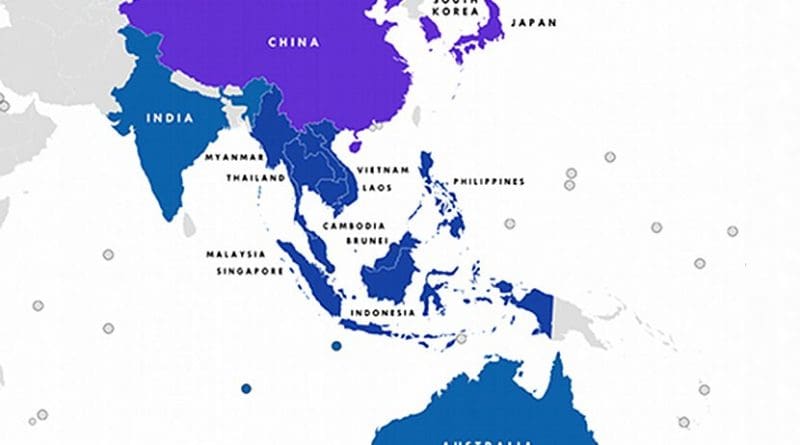The Missed RCEP Opportunities In The Philippines – Analysis
President Duterte initiated the RCEP deal in September 2021. Without a timely ratification, Philippines lost billions of dollars when they were surely needed. And new challenges may loom ahead.
Recently, the Senate finally ratified the Regional Comprehensive Economic Partnership (RCEP): the free trade deal among the ASEAN, East Asia’s growth engines (China, Japan, South Korea), Australia and New Zealand. These countries account for almost a third of the world population and the global GDP. It is the largest trade bloc in history.
For years, I have examined the development and probable futures of all major world economies, particularly considering their industrialization and modernization, economic reforms, and opening-up policies. From this perspective, the belated RCEP ratification in the Philippines means significant missed opportunities, especially in 2023.
Why RCEP could be used now
Not so long ago, the Philippine government still expected the gross domestic product (GDP) growth to soar to 6-7% this year, or even more. But recently some analysts have cautioned that economic growth is more likely to grow by 5%. That’s significantly lower than the government’s initial target.
One challenge involves the lingering inflation. Headline inflation accelerated to 8.7% in January, marking the 10th straight month that inflation exceeded the central bank’s 2-4% target. If inflation is elevated and households are rebuilding savings rather than engaging in extended, post-pandemic revenge-spending, then consumption could moderate, while rising borrowing costs are already constraining capital formation.
By the same token, business interests remain cautious, while guarding the purse strings. Why invest if people aren’t buying?
Often, in comparable situations, government rushes in to stimulate the economy. But today that’s trickier as debt ratios soared during the pandemic and fiscal space remains tight.
That still leaves trade, ideally. But the problem is that Philippine growth in 2023 could be penalized even further by a global downturn, especially its impact on Philippine exports. And while exports represent a modest portion of the economy, a slowdown of overseas remittances would pose a greater challenge to domestic consumption.
Billions of dollars in lost opportunity costs
In the Philippines, President Duterte greenlighted the deal on September 2, 2021. Signed in November 2020, the RCEP became effective on January 1, 2022. By then, Singapore, China and Japan had already ratified it, to benefit from the first-mover advantages.
The longer the delay, the greater the lost opportunities, warned Ramon Lopez, the head of the Department of Trade and Industry, already over a year ago. “Late joining, opt-out of RCEP sends wrong signal to investors.”
Despite Duterte’s timely initiative, the Senate began hearings on the deal only in early November and the deal was not ratified by January. By then another 5 ASEAN countries, plus Australia, New Zealand and South Korea had also ratified it.
Long delays ensure that that other signatory countries will benefit from the early-mover advantages, which has left the Philippines further behind in regional efforts to attract foreign direct investment (FDI). After all, to Manila the RCEP is an instrument to attract new foreign investment. It can secure access to cheaper raw materials and intermediate goods for export and local industries.
In the early 2020s, the RCEP accounted for some 50% of Philippine exports and 68% of Philippine import sources, Dr Henry Lim Son Liong, President of the Filipino-Chinese Chamber, estimated at the time.
Importantly, the pact would expand access to overseas markets for domestic goods and services, especially for small and medium enterprises (MSMEs). That’s vital for job-creation since the MSMEs, unlike the capital-intensive big business, have a significant employment effect.
In terms of its aggregate impact, the RCEP could increase the Philippine GDP by up to 2 percent, according to some analysts. Since the country’s nominal GDP was $402 billion in 2022 and is estimated at $425 billion for 2023, that could amount to up to 8.3 billion – that is, in lost opportunity costs.
Time to choose between development and geopolitics
The higher the growth rate, the faster the country can make up for lost ground. Unfortunately, the consequences of procrastination are heavy in economic costs and worse in strategic losses, which, coupled with the dire international landscape, may also penalize the anticipated Philippine growth.
The ongoing energy and food crises, which are the direct result of the failure of international diplomacy in Ukraine and the associated military sales bonanza, are sustaining elevated inflation. That, in turn, will extend the duration of high interest rates that will further downgrade growth prospects in the Philippines, too.
Still worse, if in the future Philippine exports are needed to offset the challenges of consumption, investment and government spending, the ongoing realignment of Manila into potentially lethal military entanglements could alienate the country’s largest export destination, second-largest source of investment and critical reservoir of tourism – that is, China.
As secular stagnation spreads in the West, those large emerging economies that are peaceful, stable, and development-driven will thrive. Those that opt for militarization, instability and geopolitics won’t. The lessons of history are compelling.
Chinese tourism as a harbinger of the future?
During Duterte’s era of independent foreign policy, over 1.7 million Chinese tourists visited the Philippines in the pre-pandemic 2019, an increase of 39 percent from 2018. While in the country, they spent more than 2.3 billion U.S. dollars.
In January 2023, the number of Chinese tourists was less than 7,000. And while the annualized figure may increase significantly monthly, it could prove just a fraction of the 2019 level. Meanwhile, Thailand estimates that 12-15 million of its expected 30 million tourists may come from China this year.
That’s a telling indicator of the lost opportunities in 2023 and, when the militarization kicks in more widely, far beyond.
The original version was released by The Manila Times on February 28, 2023

